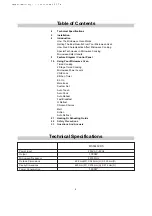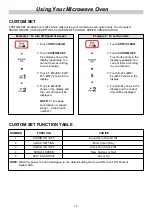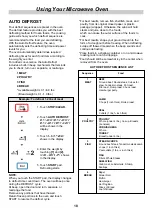
6
Introduction
How the Microwave Oven Works
Microwaves are a form of energy similar to radio and
television waves and ordinary daylight. Ordinarily,
microwaves spread outwards as they travel through
the atmosphere and disappear without effect.
Microwave ovens, however, have a magnetron which
is designed to make use of the energy in microwaves.
Electricity, supplied to the magnetron tube, is used to
create microwave energy. These microwaves enter the
cooking area through openings inside the oven. A
turntable or tray is located at the bottom of the oven.
Microwaves cannot pass through metal walls of the
oven, but they can penetrate such materials as glass,
porcelain and paper, the materials out of which
microwave-safe cooking dishes are constructed.
Microwaves do not heat the cookware, though cooking
vessels will eventually get hot from the heat generated
by the food.
A very safe appliance. Your microwave oven is one
of the safest of all home appliances. When the door is
opened, the oven automatically stops producing
microwaves. Microwave energy is converted
completely to heat when it enters food, leaving no “left
over” energy to harm you when you cook your food.
Getting The Best Results From Your
Microwave Oven
Keeping an eye on things.The recipes in this book
have been formulated with great care, but your
success in preparing them depends, of course, on how
much attention you pay to the food as it cooks. Always
watch your food while it cooks. Your microwave oven
is equipped with a light that turns on automatically
when the oven is in operation so that you can see
inside and check the progress of your
recipe.Directions given in recipes to ‘elevate’, ‘stir’, and
the like should be thought of as the minimum steps
recommended. If the food seems to be cooking
unevenly, simply make the necessary adjustments you
think appropriate to correct the problem.
Factors affecting cooking times. To check the
wattage of your oven, refer to the specifications at the
beginning of this book. Many factors affect cooking
times. The temperature of ingredients used in a recipe
makes a big difference in cooking times.
For example, a cake made with ice-cold butter, milk,
and eggs will take considerably longer to bake than
one made with ingredients that are at room
temperature. All of the recipes in this book give a
range of cooking times. In general, you will find that
the food remains under-cooked at the lower end of the
time range, and you may sometimes want to cook your
food beyond the maximum time given, according to
personal preference. The governing philosophy of this
book is that it is best for a recipe to be conservative in
giving cooking times. While undercooked food is
ruined for good. Some of the recipes, particularly those
for bread, cakes, and custards, recommend that food
be removed from the oven when they are slightly
undercooked. This is not a mistake. When allowed to
stand, usually covered, these foods will continue to
cook outside of the oven as the heat trapped within the
outer portions of the foods gradually travels inward. If
the foods are left in the oven until they are cooked all
the way through, the outer portions will become
overcooked or even burnt. As you gain experience in
using your microwave oven, you will become
increasingly skillful in estimating both cooking and
standing times for various foods.
How Food Characteristics Affect
Microwave Cooking
Density of foods: Light, porous food such as cakes
and breads cook more quickly than heavy, dense
foods such as roasts and casseroles. You must take
care when microwaving porous foods that the outer
edges do not become dry and brittle.
Height of foods: The upper portion of tall foods,
particularly roasts, will cook more quickly than the
lower portion. Therefore, it is wise to turn tall foods
during cooking, sometimes several times.
Moisture content of foods: Since the heat generated
from microwaves tends to evaporate moisture,
relatively dry foods such as roasts and some
vegetables should either be sprinkled with water prior
to cooking or covered to retain moisture.
Bone and fat content of foods: Bones conduct heat
and fat cooks more quickly than meat. Therefore, care
must be taken when cooking bony or fatty cuts of meat
that they do not cook unevenly and do not become
overcooked.
Summary of Contents for MS5646VRS
Page 24: ......







































